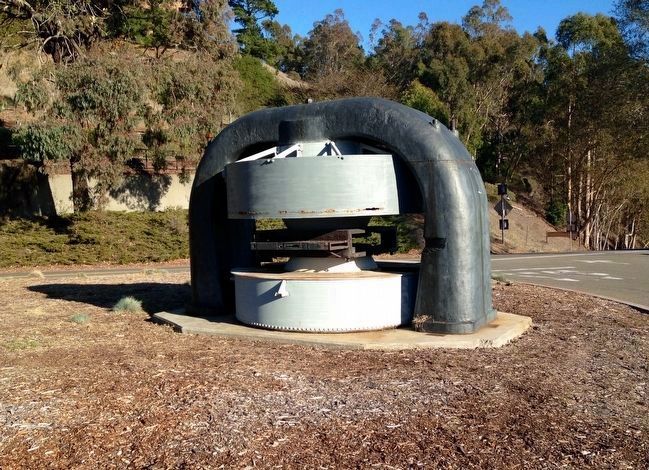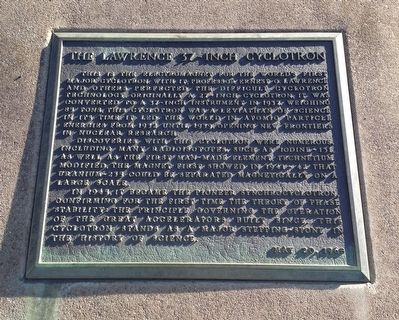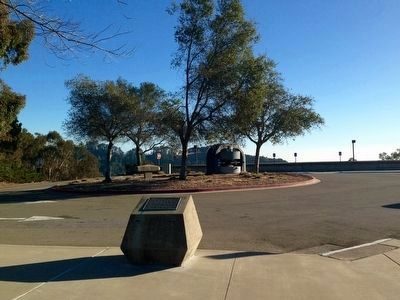Berkeley in Alameda County, California — The American West (Pacific Coastal)
The Lawrence 37-Inch Cyclotron
Discoveries with this cyclotron were numerous, including radioisotopes, such as iodine-131, as well as the first man-made element, technetium. Modified, the magnet first showed in 1941-42 that uranium-235 could be separated magnetically on a large scale.
In 1945, it became the pioneer synchrocyclotron, confirming for the first time the theory of phase stability: the principle governing the operation of the great accelerators built since. This cyclotron stands as a major stepping-stone in the history of science.
May 20, 1968
Erected 1968.
Topics. This historical marker is listed in this topic list: Science & Medicine. A significant historical year for this entry is 1937.
Location. 37° 52.762′ N, 122° 14.758′ W. Marker is in Berkeley, California, in Alameda County. Marker is on Centennial Drive south of Grizzly Peak Boulevard, on the left when traveling south. Touch for map. Marker is at or near this postal address: 1 Centennial Drive, Berkeley CA 94720, United States of America. Touch for directions.
Other nearby markers. At least 8 other markers are within walking distance of this marker. Temple of Wings (approx. 0.6 miles away); Annie and Bernard Maybeck House (approx. 0.6 miles away); John Fitzgerald Kennedy Charter Day Speech (approx. 0.6 miles away); Jensen House (approx. 0.6 miles away); Daley’s Scenic Park Street Improvenents (approx. 0.6 miles away); Cloyne Court Hotel (approx. 0.7 miles away); Ernest V. Cowell Memorial Hospital (approx. 0.7 miles away); Allenoke Manor (approx. 0.7 miles away). Touch for a list and map of all markers in Berkeley.
More about this marker. The marker is found on the grounds of the Lawrence Hall of Science.
Also see . . . Cyclotron - Wikipedia. "A cyclotron is a type of particle accelerator invented by Ernest O. Lawrence in 1932 in which charged particles accelerate outwards from the center along a spiral path. The particles are held to a spiral trajectory by a static magnetic field and accelerated by a rapidly varying (radio frequency) electric field. Lawrence was awarded the 1939 Nobel prize in physics for this invention. Cyclotrons were the most powerful particle accelerator technology until the 1950s
when they were superseded by the synchrotron, and are still used to produce particle beams in physics and nuclear medicine...." (Submitted on December 24, 2015.)
Additional keywords. physics chemistry

Photographed By Andrew Ruppenstein, December 25, 2013
3. The Lawrence 37-Inch Cyclotron
"In 1928 Ernest Lawrence of the University of California, inspired by the work of Widerøe, had the idea of utilizing a curved path for a particle accelerator. A magnetic field perpendicular to the plane of motion of an accelerated particle will result in the particle taking a curved path. By studying the simple relationship between the forces acting on the particle, Lawrence realised that the increase in the radius of the path taken by the particle is compensated for by the increased velocity of the particle if the magnetic field, the charge of the particle and the particle's mass remain constant. With this in mind, he built what became known as a Cyclotron...." - Accelerators for Society
Credits. This page was last revised on August 27, 2020. It was originally submitted on December 24, 2015, by Andrew Ruppenstein of Lamorinda, California. This page has been viewed 1,868 times since then and 84 times this year. Photos: 1, 2, 3. submitted on December 24, 2015, by Andrew Ruppenstein of Lamorinda, California.

